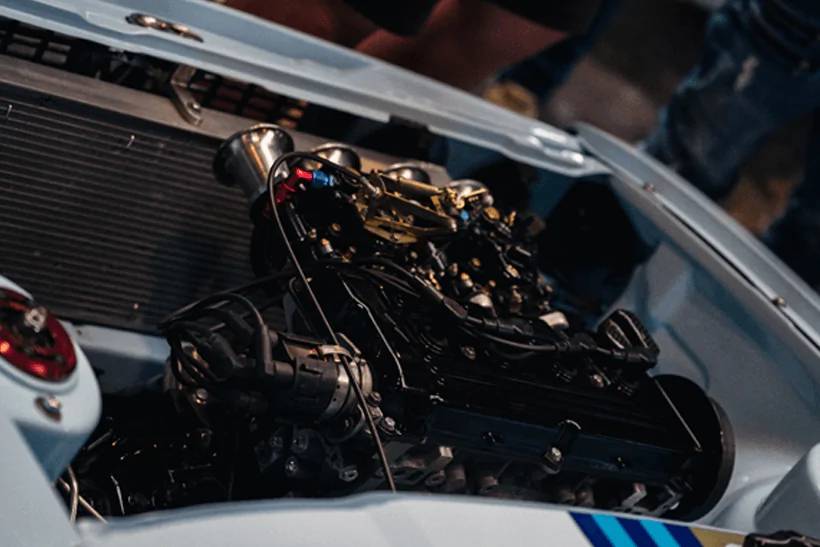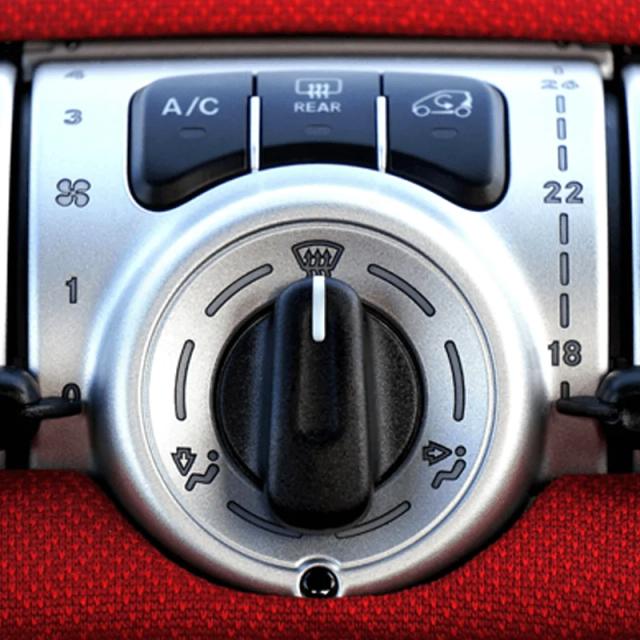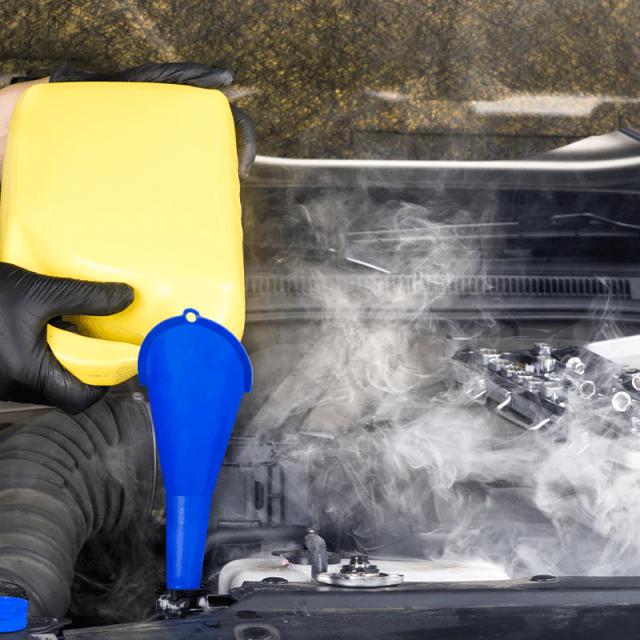
Located at the front of your car, just behind the grill, is the car radiator. This radiator for your vehicle is a critical component in a vehicle's cooling system, keeping the engine running at the optimum temperature.
However, if you have steam or a hissing sound from under your bonnet or coolant dripping from the underside of your vehicle. If you've noticed any of these symptoms, you've likely got a car radiator leak on your hands. When your cooling system springs a leak, your engine is at risk of overheating, and if left untreated, it could lead to a total engine failure.
If you need a replacement car radiator, you can easily find the correct one by entering your reg or make and model on our car radiator page.
In this guide, we'll guide you through car cooling system troubleshooting, take a look at the causes of a leak, and then walk you through a car radiator repair.
What Does the Car Radiator Do?
How Can I Tell if the Radiator Is Leaking? 6 Simple Signs
5 Common Reasons Your Car Radiator is Leaking
How to Stop and Fix a Car Radiator Leak
Car Radiator Leak Know-How
What Does the Car Radiator Do?
Car engines convert fuel into energy using combustion. Spark plugs inside the engine cylinders ignite the fuel in a controlled explosion, producing the power that propels the vehicle forward.
Naturally, these explosions also create a lot of heat, which means the engine gets intensely hot while running. If it overheats, it could cause the entire engine to fail. On the other hand, if the temperature falls too low, the fuel economy will drop, and CO2 emissions will increase. That's why a cooling system is needed to regulate the heat and keep the engine at just the right temperature.
A car radiator is the part of the cooling system that prevents the engine from overheating. This cooling system is a series of coolant pipes filled with liquid coolant circulated through the engine by the coolant pump.
This coolant is then pumped into the radiator located at the front of the car behind a grill. The radiator usually consists of two tanks connected by a series of narrow tubes and wires, increasing the radiator's surface area. The air streaming through this grill as the car moves forward cools the radiator, keeping the engine at the right temperature to run correctly.
How Can I Tell if the Radiator Is Leaking? 6 Simple Signs
It can sometimes be difficult to tell if a problem is in the cooling system or somewhere else in the vehicle. Thankfully, with our car cooling system troubleshooting advice, you should be able to tell if you've got a car radiator leak on your hands and if you need to perform a car radiator repair.
Radiator Fluid Is Leaking Under the Car
If a patch of coolant is leaking underneath your car, it's a sure sign that you've got a leak in the cooling system. But before you try to locate the source of the leak, you want to be confident that the fluid puddling under your car is definitely engine coolant, as it could also be oil, power steering fluid, or just water.
You should be able to do this by looking closely at the spill. Coolant is usually green or orange in colour, depending on the type of antifreeze in the vehicle, so look closely. Engine oil usually is more yellowish, or even dark brown or black, depending on how long it's been in the vehicle. Coolant also has a viscous, almost slimy consistency and a slightly sweet smell. In contrast, engine oil has a greasy texture and an iridescent sheen.
If your vehicle has power steering, it could also be power steering fluid, usually red or reddish brown in colour. If the spill is colourless, it could just be water, especially if you've been driving with your air conditioner running, as condensation will often drip down from the compressor.
The Car Radiator Is Hissing
When the radiator is hissing, it's another sign that coolant is leaking, either from the radiator or another cooling system component. It could also mean that your radiator fan is malfunctioning, so the water in the radiator isn't adequately cooled. Or, it could indicate that your radiator cap is leaky, allowing pressure to escape.
The Engine Is Overheating
A radiator leak will stop your cooling system from working correctly, meaning the engine will soon overheat. If the temperature warning light appears or steam is coming from under the bonnet, a leak or malfunctioning part will likely be the culprit.
The Radiator Is Rusty and Corroded
Water leaking from the radiator can rust the exterior, so check it carefully for signs of corrosion. It can be easier to see this when the radiator is clean, so wash it thoroughly with a hose (make sure the engine has completely cooled before attempting this). Then, examine it carefully, paying close attention to the underside, as this is where rust is most likely to form as the leaking coolant runs down. If the rust is concentrated in a particular area, this is likely to be the leak's location.
Coolant Level Has Dropped
Most modern cars have a sealed cooling system, so the coolant level should remain constant. If it drops, it's a sign that you've got a leak somewhere in the system.
You can quickly check this by looking at the see-through radiator water tank under the bonnet while the engine is switched off and cooling (check the manual to locate this if you're unsure). It should be between the minimum and maximum marks on the tank.
If it's low or nearly empty, you can move on to checking the coolant level in the radiator. To do this, find the radiator cap: a pressurised cap on top of the radiator. Cover the cap with a rag to protect yourself from leaks or steam, and press down and twist to release the cap. The coolant level should be near the top of the reservoir (some cars have a link marking to indicate the correct level). If it's low, there may be a leak.
Your Car Runs Hot, but the Radiator Is Cool
When the car is running hot, but the radiator is cool, the radiator may not be causing the problem: a faulty thermostat could be to blame. The thermostat is a temperature-sensitive valve that controls the coolant flow through your engine. When the engine gets too hot, the valve opens to allow coolant to flow through the engine, and when the engine is cold, it closes to let it warm up. This regulates the vehicle's temperature to keep it at the optimum level.
But when the thermostat is faulty, it can become stuck in the closed position, preventing coolant from flowing into the engine and causing it to rapidly heat up. If the engine continues to run like this, it could fail, so it's essential to stop the engine and fix or replace the valve.
To learn more about how to solve this problem, check out our guide on car thermostats. You can also get yourself a new thermostat here for many makes and models.
5 Common Reasons Your Car Radiator is Leaking
There can be any number of causes for a car leaking radiator fluid. Here, we've shared some of the most common issues to help troubleshoot and work out how to fix it.
Stuck or Faulty Radiator Cap
The radiator cap is a pressurised cap at the top of the radiator. It's designed to let minimal air out of the system when necessary to maintain the correct pressure level. If the cap gets jammed, pressure will build up inside the system, eventually causing the radiator hose to crack or break, causing a leak. The cap itself can also start to leak coolant if it becomes damaged. If you notice radiator fluid around the cap and near the radiator, then it's a likely sign that the cap will need to be replaced. You can find replacement caps for many vehicles in our car radiator cap page.
A Leak in the Head Gasket or Engine Block
The head gasket is a ringed panel positioned between the cylinder head and the engine block. The purpose of the head gasket is to stop the engine oil, coolant, and fuel from leaking into the cylinders. Coolant fluid could leak out, often along oil and fuel, should the gasket become damaged.
Another sign that your gasket is broken is thick clouds of white steam coming out of the exhaust: this is steam coming from the coolant that has leaked into the hot engine. Left untreated, a blown head gasket could cause your car to overheat, so getting it repaired as soon as possible is crucial. You can easily troubleshoot your exhaust smoke with our exhaust smoke guide.
We have a range of head gasket sets suitable for a vast range of car makes and models.
Worn Out or Leaky Water Pump or Radiator Hose
The water pump drives coolant through the cooling system, but, like any other part, it can be subject to wear and tear over time. It can also be cracked or damaged by impact from sudden knocks and jolts – like hitting a pothole while driving, for instance.
A faulty, leaking pump can't usually be repaired, so you'll likely need to replace it. Just head over to our cooling system page to find your new water pump.
Damage From Road Debris or Impact
As the radiator is located right at the front of the vehicle, road debris can sometimes be thrown up through the grill, damaging the radiator and causing a leak. It can also become damaged by jolts, bumps, or collisions. You can usually find the damage by inspecting the radiator carefully. A damaged radiator will often need to be entirely replaced.
Cold Weather
Icy weather is another common culprit behind damaged radiators. Water expands when it freezes, and if the coolant inside the engine is allowed to freeze in the cold, it can crack the radiator or burst the radiator hose.
This is why adding antifreeze – usually ethylene glycol – is essential to the coolant, as this lowers the freezing point. The recommended antifreeze level for most vehicles is a 50:50 ratio – in other words, equal parts antifreeze and water. While antifreeze is designed to last for at least a few years, engine coolant degrades over time and can gradually boil off. So, it's important to top it up regularly – preferably before winter. You should also flush the radiator every few years to clean it out and remove any contaminants that could stop it from working properly.
How to Stop and Fix a Car Radiator Leak
Before you begin fixing a car radiator, you'll need to identify the exact location of the leak – remember, it may not be the radiator itself but another part of the cooling system. If you've ruled out the possibility of a leak elsewhere in the system, you'll need to either use a radiator repair sealant or replace the car radiator entirely.
Using a Repair Sealant System
If the leak is very small (barely visible to the naked eye), you may also be able to use a radiator repair sealant additive to repair pinpoint leaks. These products are added to your cooling system via the reservoir. They will expand to fill and seal the crack and, as a result, are usually more of a temporary fix. But remember, they won't do anything for severe leaks and damage. However, they can be useful to get your car up and running to take it to a garage.
Flush and Replace the Radiator
You'll need to fully replace the radiator when it is severely damaged or cracked. This can be a complicated process, so if you're not confident about doing it yourself, we suggest enlisting the help of a qualified mechanic. You can find your brand new car radiator over in our car radiator section.
Cooling system leaks can be incredibly difficult to spot. If you still can't find the leak after a thorough visual inspection, take the car to a mechanic, who can use specialist pressure-reading tools to identify which part of the cooling system is the source of the leak.
Car Radiator Leak Know-How
If you're replacing the radiator yourself, remember that you'll need to drain all the fluid out of the system first before you begin fixing your car radiator: you can learn more about this in our guide on how to flush a radiator.
A car radiator leak can reduce the effectiveness of your entire cooling system. If you don't get it repaired, it could cause your entire engine to overheat – which can cost a pretty penny to fix. This guide should help you work out whether it's your radiator or another part of the cooling system that is leaking so you can identify the source of the problem and get it sorted as soon as possible.
Shop Car Radiators at GSF Car Parts Online and In-Store
All our car radiators are from trusted brands in the motoring industry, so you can count on them to be reliable and of excellent quality. Plus, our low-price promise means you can always expect great value, too.
We offer free UK delivery on all online orders over £25, plus 60-day returns*. We also know you want to get your car up and running as soon as possible, which is why we offer a Click and Collect service that allows you to get your new car radiator in just an hour.
So, buy car radiators from us with confidence today. Or if you're close to one of our 180 store locations across the UK & Ireland, drop by. Our experienced staff will be able to direct you to the correct part for your vehicle.



